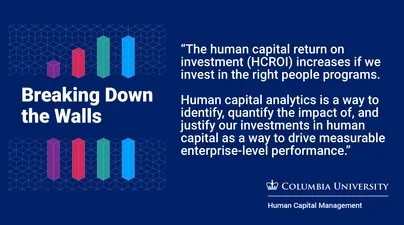Columbia University’s Master of Science in Human Capital Management (HCM) program offers an innovative course of study that emphasizes strategic thinking and data-driven decision making. These two pillars were at the forefront of a recent event, Breaking Down the Walls: Applying Human Capital Analytics Across Functions to Unlock Organizational Performance and Career Growth.

Dr. Solange Charas, HCM Adjunct Lecturer, introduced an approach that reframes the HR function as more than the traditional, “stand-alone”, siloed function working in parallel with other functions in the organization. Instead, Dr. Charas explained, HR is an essential actor in an integrated system that supports the enterprise across all functions by using analytics to drive business results. She explained, “As HR people, sometimes we get blinkered and we only think about our human capital program effectiveness.” However, she notes that the HR function’s focus should be “connected to the business and we need to think about that. We need to start breaking down those walls within the organization, and it has to start with our own thinking.”
To organize human capital analytics thinking, Dr. Charas recommended a mind-mapping platform that allows HCM professionals to organize their thoughts about the identification of the “pathway” between all aspects of HR and enterprise-level performance -- ultimately ensuring a systemic approach to the inquiry. One benefit of these “mindmaps” is to fully specify HR program interdependencies -- those HR programs that are required for specific enterprise-level goal achievement. According to Dr. Charas, the human capital return on investment (HCROI) increases if we invest in the right people programs, “and human capital analytics is a way to identify, quantify the impact of, and justify our investments in human capital as a way to drive measurable enterprise-level performance.”
Dr. Charas then turned the conversation over to Dr. Aaron Wallen, HCM Senior Lecturer, who moderated a panel of experts to share insights and their own experiences in applying this framework. The panel included:
Dr. David Landman, the Managing Director and Global Head of Talent Assessment at Goldman Sachs, described a new approach for performance management that was designed to help employees increase their performance and impact. Dr. Landman led a process at Goldman Sachs to create more defined moments for employees and managers to check-in throughout the year, with an emphasis on setting goals, holding coaching conversations and, at the end of the year, looking back on performance. Referencing Dr. Charas’ framework, Dr. Landman stated, “In building this new approach, we’ve really broken down the walls and silos and worked across the enterprise to create it.” Dr. Landman continued, noting “the starting point for us was the enterprise-level outcome of the firm’s strategic priorities, then aligning our HR strategy to help enable business performance.” Dr. Landman reflected that this prompted a broad cultural change and process change for Goldman Sachs. “This human capital issue touched practically every function both of HR and well beyond,” he observes.
Dr. Genetha Gray, Lead People Research Scientist at Salesforce, echoed Dr. Landman’s reference to broad cultural change within an organization. In her example, she cited the process of working through the shifts in a post-COVID world. A year ago, the shift to remote working was akin to building a plane while flying. She notes, “We had no choice; everyone had to go home and we had to figure out how to be productive.” However looking ahead, it’s possible to have a more deliberate plan about who works from where and when. “It affects everyone in the company, and it’s a huge, huge cultural shift,” Dr. Gray said. “We can never underestimate how much impact a cultural shift has on business outcomes, so this is a key part of where HR analytics has to come in and help everyone understand how we can measure and track as we go.”
Google’s Director of People Analytics, Jennifer Kurkoski, offered an example of examining the question, as opposed to the data. The question she addressed: “Do we need managers?” Dr. Kurkoski described Google’s exploration of managers’ value within an organization, looking both at upward assessments from the people who report to them and downward from their leaders. The exercise involved using surveys and performance review data to get a measure of quality and capability. Although the outcome was not necessarily surprising—managers indeed matter—the key for Dr. Kurkoski was making sure change happened as a result of her findings. “It informed our training, it informed our evaluation, it informed our development,” she explained. “All of those things were based in part on that research, and it became something people could point back to.” Dr. Kurkoski also noted that the learnings even found their way into the language at Google. “The question matters,” she concluded, “and then orienting on what you’re going to do with it.”
HCM Adjunct Lecturer Mark Baker, who also serves as the Global Director of HR Analytics and Strategy for Abbott Labs, offered his own advice: “I think a framework like this is extremely useful when you really start with it early and not when you actually have a project.” He proceeded to outline a situation where one of Abbott’s key business units had a major growth initiative to get out to the market very quickly. Using data elements, the team was able to put a plan together, from creating better profiles for hiring to accelerating the training and onboarding process. “Having this framework in place was really something we established early and assessed regularly,” Mr. Baker explains. “It was key for us to have something to work against.”
In summary, as Drs. Charas, Wallen and the four esteemed panelists agreed that Human Capital Management functions have the most impact when they are thought of as “part of a whole,” as an integrated system of programs and processes that can impact business outcomes… if we Break Down the Walls and develop, manage and measure them properly.